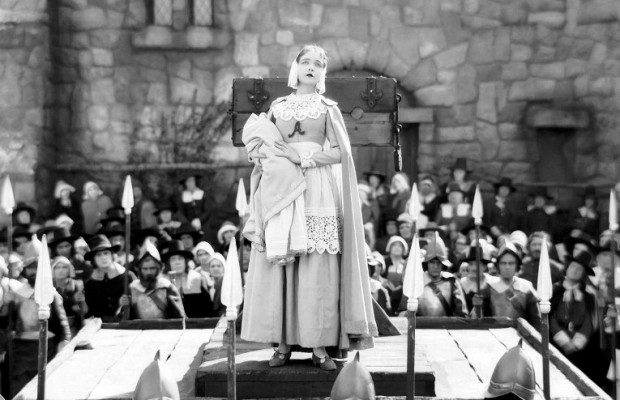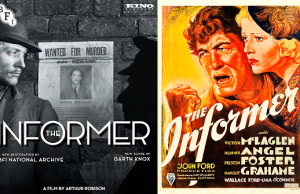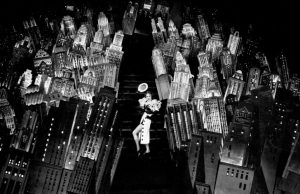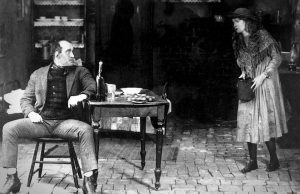The Scarlet Letter (1926)

Toronto Film Society presented The Scarlet Letter (1926) on Monday, February 11, 1957 as part of the Season 9 Monday Evening Silent Film Series, Programme 5.
Two Humanists – Chaplin and Seastrom
The Immigrant (USA 1917) Produced by Mutual. Written and directed by Charles Chaplin. With Chaplin and Edna Purviance.
One of Charlie’s famous Mutual comedies of the rich 1916-17 period. While others like The Cure and The Rink had provided rather violently wonderful fun, The Immigrant is one of the first Chaplins in which touches of gentleness, pathos and social comment appear. The Statue-of-Liberty bit and the restaurant sequence are classic.
INTERMISSION
The Scarlet Letter (USA 1926) Produced by Metro-Goldwyn-Mayer. Screenplay by Frances Marion, from the novel Nathaniel Hawthorne. Directed by Victor Seastrom. Cast includes: Lillian Gish, Lars Hanson, Henry B. Walthall and Karl Dane.
Of this film version of the book ranked by many with Melville’s Moby Dick at the top of American literature, Paul Rotha in The Film Till Now wrote: “It is remarkable for the playing of Lillian Gish as Hester Prynne, a very different woman from Griffith’s young lady, and for the appearance of lars Hanson, just come from Sweden. The theme of The Scarlet Letter was gloomy, but Seastrom raised its gloom to moments of great beauty. It was a film made in one key, for even the humorous relief of the stocks and the ducking-stool were fitted into the pattern of sorrow. Seastrom’s sweeping sense of landscape, so evident in his early Swedish films, was expanded and gave an enchanting atmosphere to the first love scenes between Miss Gish and Hanson. This feeling for depth and space was common to all the Scandinavian directors; with Seastrom it manifests itself in his shots of landscape, his feeling for the presence of the elements, his love of wind, sky and flowers. Perhaps it is in accord with the dusty desert of the American Westerns and the chimneys and smoke of the Soviet workers’ films. Perhaps it is due to the natural Swedish tendencies towards the beauty of nature and the rhythm of poetry. Seastrom took this reality of nature with him to the mechanized studios of Hollywood, and it blossomed even in that hot-house atmosphere. Nearly all the themes of Seastrom are connected with the struggle of human beings against the common mass of humanity. He is concerned with individual persons and their relationship to their environment, e.g., Hester Prynne set against the narrow-mindedness of the conventional people in The Scarlet Letter.”
The Director
Victor Seastrom (Sjostrom), noted for some years as director of and actor in such Swedish films as The Phantom Chariot, preceded his compatriots Greta Garbo and Mauritz Stiller to Hollywood in the early 20’s. Specializing in stark, sometimes semi-symbolic dramas of grim lives in harsh communities, he made among other films in the US: Name the Man with Mae Busch and Conrad Nagel (from Sir Hall Caine’s The Manxman); The Tower of Lies with Lon Chaney, Norma Shearer and William Haines (from his countrywoman Selma Lagerlof’s Emperor of Portugallia); He Who Gets Slapped, from Andreyev’s play, with Chaney, Shearer and John Gilbert; The Masks of the Devil with Gilbert; Divine Woman with Garbo as a thinly-disguissed Sarah Bernhardt; The Wind with Lillian Gish and Lars Hanson. His first dialogue–and last Hollywood–film was A Lady to Love, with Vilma Banky and Edward G. Robinson, from the play They Knew What They Wanted, also filmed twice by others and now musicalized on Broadway as The Most Happy Fella! In 1930 Seastrom left America for good to return to the Swedish cinema.
Lewis Jacobs in The Rise of the American Film says: “Like Murnau, (The Last Laugh, Sunrise) Seastrom aimed to express a universality in films, and to do it with simplicity and sincerity. He, too, depended upon the creation of mood. In approach, however, these men were widely different. Murnau was subjective, interested mainly in the camera eye; Seastrom, more objectibe, concerned himself with characterization through acting and with the forces of nature. In his pictures, as in von Stroheim’s, the work of the camera is not particularly noticeable; the cutting is academic. It is the relevant details placed within the scene as a whole that make the film significant. Watching a Murnau picture, one is always aware of the amazing technique involved; it is only after seeing a Seastrom film that one becomes fully aware of its power. One of the first foreign directors to come to Hollywood during the ‘foreign invasion’, Seastrom had been a leading figure in Swedish cinema since 1912. Although achieving little public renown in the U.S., he made a number of notable productions, of which one is particular, The Wind, is one of the finest achievements among silent American films. In technique, Seastrom was a director of distinguished talent; in subject matter, a man of keen social outlook. All his pictures had a lyrical approach, the strength of honest characterization, and social awareness. The theme of his films was always man in conflict with society and nature; they dealt in the larger emotions and the whole was rendered simply and lyrically. Never spectacular or sensational, his films did not get the attention they desserved. In 1927, however, he was finally singled out, because of The Scarlet Letter, as one of the ‘ten best directors in Hollywood’. Though one of the best of the silent-era directors, he has had very little influence on the American screen. His propensity for psychology, realism, and the rendering of the characters of people close to the soil, had little popularity in the late twenties, and what contributions he may have made to American films were obscured by the regard for commercial values. He was nevertheless a rare director, whose work, in the words of a British critic of the day, ‘gives us state of mind more clearly than purely psychological interpretation would. Without tricks, dissolves and all that–his films may not be true, pure cinema; but the cinema there is in them is pure, and their own, which is why they breathe a nobility unlike any other films’ nobility’.”
The Star
“Under the European influence of this period, the style of screen acting became more defined and farther removed from the stage gestures of pre-war days. A restrained naturalism was cultivated. Victor Seastrom endorsed a restraint in acting and pantomime that made for a minimum of gestures. Lillian Gish, after playing under him in The Scarlet Letter, declared: ‘His direction was a great education for me. In a sense I went through the Swedish school of acting. I had got rather close to the Italian school in Italy (The White Sister, Romola). The Italian school is one of elaboration, the Swedish one of repression’.”
Many feel that Miss Gish, though brilliantly handled by Griffith in some of his films, reached maturity as a silent screen actress in this later period. She remains, of course, to this day a distinguished sound-film, stage and television artist. Her last films were The Cobweb and The Night of the Hunter.














Leave a Reply